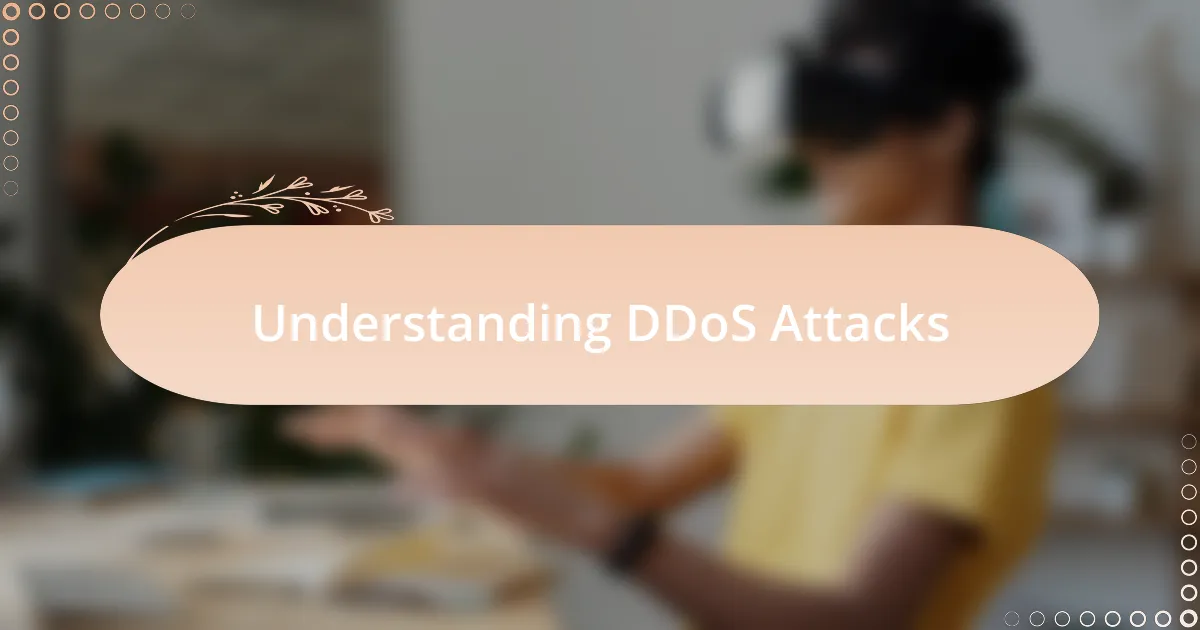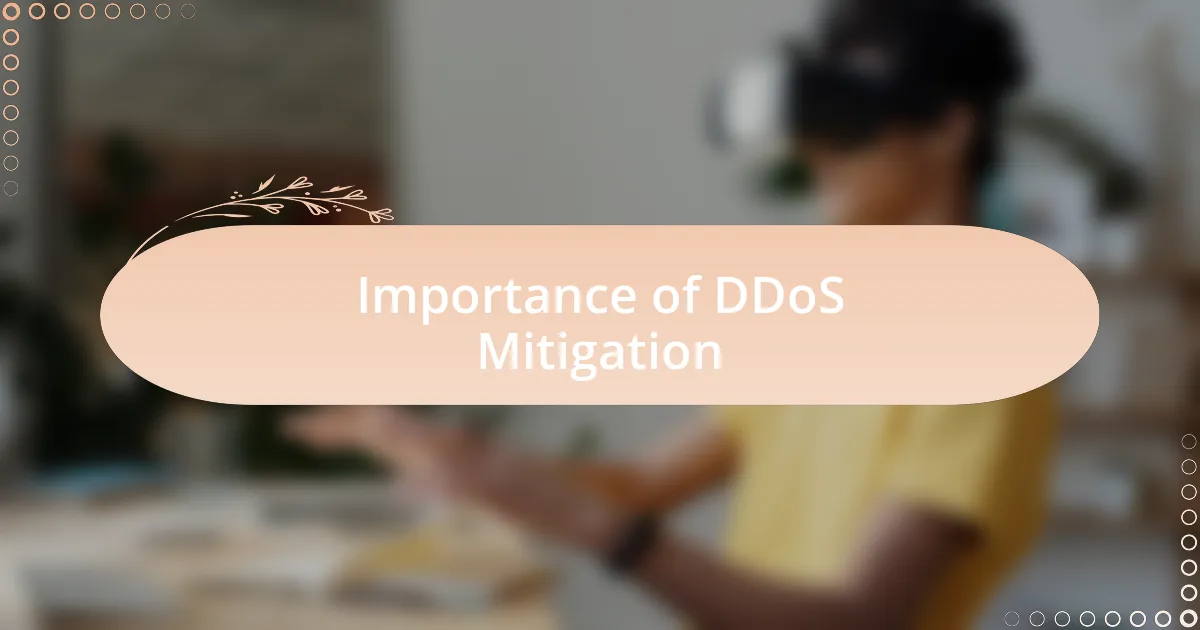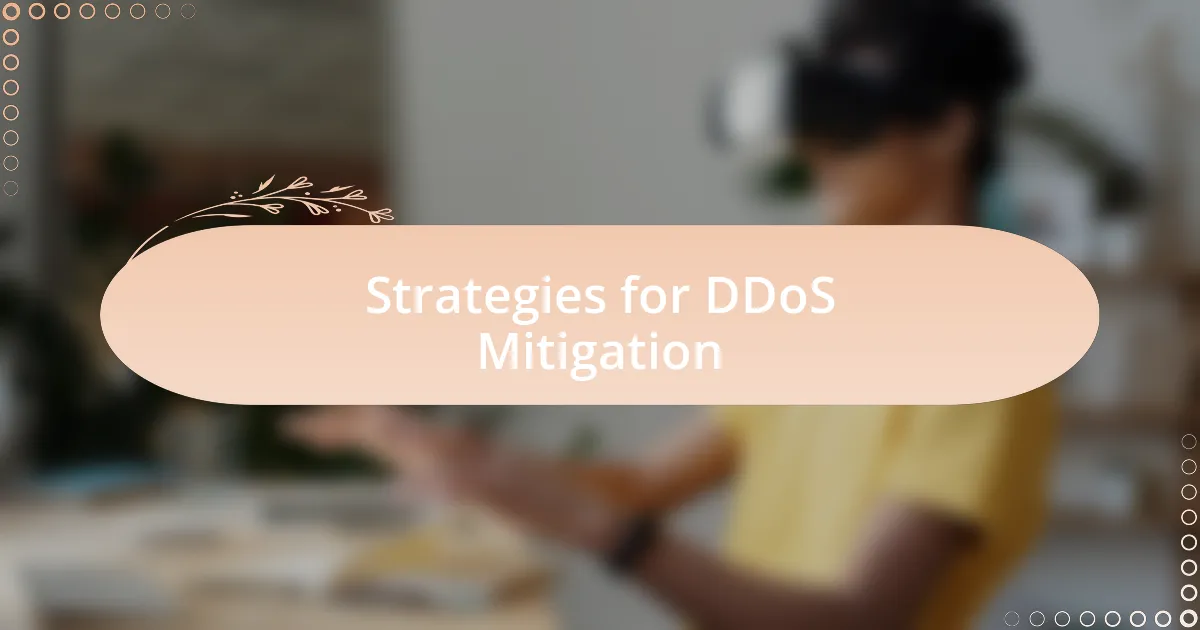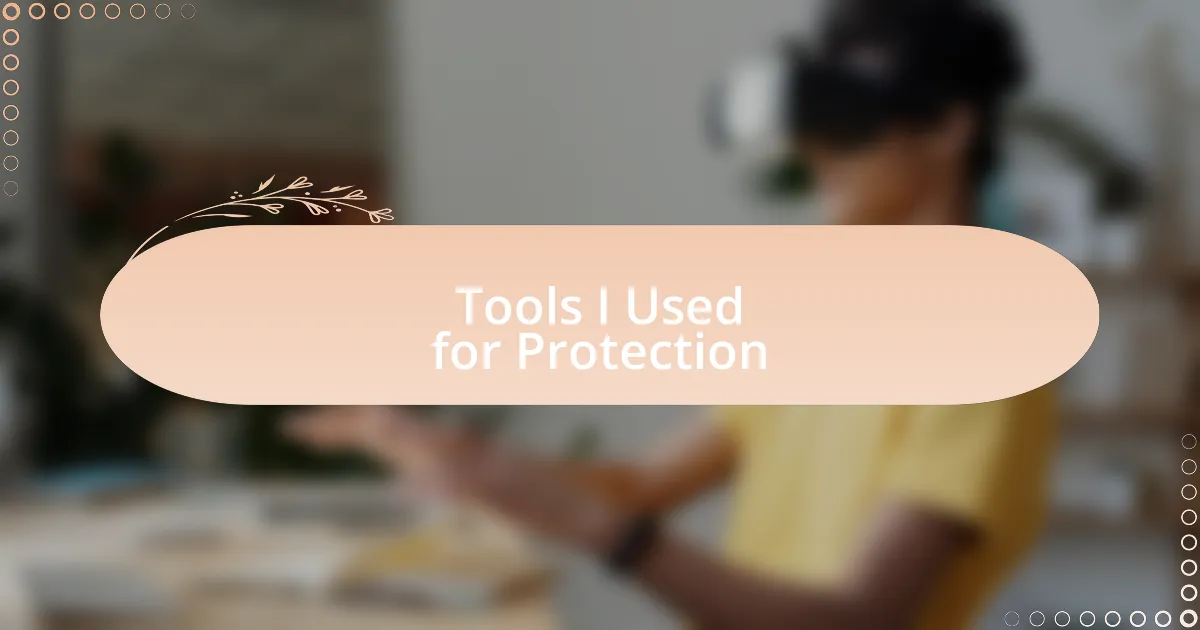Key takeaways:
- DDoS attacks overwhelm websites by flooding them with traffic, causing significant disruption to legitimate users and businesses.
- Effective DDoS mitigation strategies include rate limiting, using Content Delivery Networks (CDNs), and continuous monitoring of traffic patterns.
- Proactive planning and ongoing team education are essential in preparing for and responding to DDoS threats.
- Clear communication during and after an attack fosters trust and strengthens relationships with stakeholders and users.

Understanding DDoS Attacks
DDoS attacks, or Distributed Denial of Service attacks, overwhelm a website by flooding it with excessive traffic. Imagine your favorite coffee shop on a cozy Saturday afternoon suddenly being swarmed by an unmanageable crowd. The staff struggles to serve their regular customers, leading to disappointment and frustration. This is similar to how a website performs under the strain of a DDoS attack—legitimate users are left unable to access the services they need.
What I find particularly unsettling is the sheer scale at which these attacks can occur. They often involve networks of compromised computers, known as botnets, which are remotely controlled to launch an assault on a target. Have you ever felt the helplessness of being unable to communicate with loved ones during an outage? That’s how companies and their clients feel during a DDoS attack—caught in a digital blockade that leaves them vulnerable and disconnected.
Understanding the motivations behind DDoS attacks can provide valuable context. Many attackers are looking to extort money, seeking notoriety, or even just wanting to demonstrate their technical prowess. This raises a question: what drives someone to disrupt the digital lives of countless individuals? For me, it highlights a stark contrast between community and chaos, compelling us to explore how we can fortify our defenses against such disruptive tactics.

Importance of DDoS Mitigation
Mitigating DDoS attacks is crucial because the consequences of not doing so can be devastating for businesses and their users. I recall a time when a relatively small online retailer I knew faced a DDoS attack during their peak shopping season. The result? A day’s worth of sales vanished in an instant, leaving them with frustrated customers and lost revenue. This not only impacted their short-term profits but also damaged their reputation in the long run.
Moreover, the importance of DDoS mitigation extends beyond financial loss—it’s about trust. When a website goes down, customers may question its reliability and security. Have you ever had a bad experience with a service and hesitated to return? That’s exactly what happens when clients are repeatedly affected by these attacks. I’ve seen companies invest heavily in customer service, only to watch their hard work unravel because they couldn’t secure their online presence.
On a broader scale, adequate DDoS mitigation also plays a role in maintaining the integrity of the internet as a whole. Each attack not only disrupts individual sites but can also slow down overall network performance. I often think about this interconnectedness. What happens when one service goes down? It creates a ripple effect that can impact countless others, leading to a fragmented online experience. For me, this emphasizes the need for a proactive approach in strengthening DDoS defenses—not just for profit, but for the sake of a cooperative digital environment.

Overview of Telecommunications Technology
Telecommunications technology serves as the backbone for connecting people and devices across the globe. It encompasses a wide range of systems, including telephony, internet services, and broadcasting, all of which are crucial for seamless communication. I often ponder how different our lives would be without these technologies; can you imagine a day without your mobile phone or internet access?
At its core, telecommunications technology enables the exchange of information through various channels, such as wired and wireless networks. I’ve witnessed firsthand how advancements in this field, like fiber optics and 5G, have revolutionized not only personal communication but also business operations. It’s fascinating to think about the possibilities these innovations are creating—what new opportunities will we discover next?
Moreover, the rapid evolution of telecommunications technology is intertwining our daily lives with data and connectivity, bringing both convenience and challenges. I recall attending a conference where experts discussed the implications of IoT (Internet of Things) devices, the idea that everyday objects could soon be interconnected. It got me reflecting on how these innovations can enhance our lives yet also expose us to vulnerabilities, especially concerning security threats like DDoS attacks. Have you ever wondered how critical it is to stay ahead of these challenges while we embrace these technologies?

Strategies for DDoS Mitigation
When it comes to mitigating DDoS attacks, one of the most effective strategies I’ve encountered is the implementation of rate limiting. This tactic ensures that users can only make a limited number of requests to the server within a specific time frame. I remember a time when a sudden spike in traffic nearly crashed a website I was managing. By applying rate limiting, we were able to differentiate between genuine users and potential attackers, allowing us to maintain functionality without obstructing our legitimate audience.
Another strategy that I found invaluable is leveraging a Content Delivery Network (CDN). By distributing the load across multiple servers globally, CDNs can absorb and mitigate malicious traffic before it reaches the primary server. I still recall a moment during a significant marketing campaign when a DDoS attack threatened our launch. Thanks to the CDN we employed, our website remained stable and accessible, demonstrating the crucial role of such networks in enhancing resiliency against attacks. Have you considered how essential a CDN could be for your own web presence?
Lastly, I strongly advocate for continuous monitoring and traffic analysis as a proactive approach. Even the slightest anomaly in traffic patterns can signal an impending attack, and being alerted timely can make all the difference. I once worked on a project where we set up automated alerts for unusual traffic spikes. This foresight allowed us to implement defensive measures before the situation escalated. It’s a game-changer to know you can detect and respond to threats early—have you thought about the systems you might implement to gain that peace of mind?

My Personal DDoS Experience
During my early days in telecommunication management, I found myself facing a considerable challenge. A DDoS attack struck unexpectedly, overwhelming my company’s website during a critical product launch. The sheer panic of seeing our traffic plummet and users unable to access vital information was incredibly frustrating. I’ll never forget how we scrambled to identify the source while ensuring we communicated effectively with our users.
I vividly recall the feeling of vulnerability when our monitoring systems flagged a sudden flood of traffic. It was as if I was on high alert, sensing the storm before it hit. That experience pushed me to deepen my understanding of traffic patterns and caused me to implement more robust analysis tools. Have you ever felt that heart-racing moment of anticipating an issue before it fully reveals itself? Being proactive empowered me to take control in situations where unpredictability reigned.
What struck me most, however, was the sense of community that emerged from recovering together. Collaborating with my team to deploy mitigation strategies not only secured our site but also reinforced our bond. It felt empowering to transform a threat into a learning experience, allowing us to become more resilient. Have you had a similar moment where adversity led to growth in your field? I truly believe that each DDoS experience can teach us invaluable lessons in preparedness and teamwork.

Tools I Used for Protection
When it came to protecting our website, I turned to several reliable tools that became instrumental in our defense. One of the first interventions I employed was a Web Application Firewall (WAF). This tool analyzed incoming traffic and filtered out malicious requests, acting as the first line of defense. I was pleasantly surprised by how quickly it adapted to new threats, creating a protective barrier that felt like a safety net. Have you ever felt that wave of relief when you find a tool that just works?
In addition to the WAF, I made use of a reputable Content Delivery Network (CDN). This not only distributed our traffic across multiple servers, reducing the load on any single point, but it also allowed us to absorb traffic spikes during an attack. I remember watching the traffic metrics during a simulated DDoS attack, holding my breath as I saw the numbers climb without a corresponding dip in website performance. Knowing we could handle that level of stress made a huge difference in our operational mindset.
Finally, I integrated various monitoring tools that provided real-time analytics on user behavior and traffic patterns. These tools allowed me to identify anomalies before they escalated into significant issues. There were moments when I received alerts that felt like an early warning system, giving us crucial time to adjust our defenses. Have you ever experienced that moment of clarity as data reveals a pattern that helps you stay one step ahead? It’s an exhilarating feeling, transforming data into actionable insights that ultimately protect your team and your users.

Lessons Learned from DDoS Attacks
During the DDoS attacks, one critical lesson I learned was the importance of proactive planning. Initially, I had a reactive mindset, thinking we could simply respond to threats as they arose. However, after experiencing the chaos of an attack, I realized that developing a robust incident response plan was essential. Have you ever faced a crisis and wished you had been better prepared? This shift in thinking not only improved our readiness but also built a culture of preparedness within the team.
Another insight was the necessity of ongoing education for my team. The rapid evolution of DDoS tactics meant that everyone needed to stay informed about the latest threats. I organized regular training sessions and discussions around cybersecurity trends. I vividly recall one session where a cybersecurity expert shared stories of real-world incidents. It clicked for everyone—suddenly, these abstract threats felt personal and tangible. How can you effectively safeguard your assets if your team doesn’t understand the landscape? This was a turning point for us, reinforcing the need for continuous learning.
Lastly, investing in communication channels proved invaluable during and after the attacks. When the first wave hit, I learned that transparency with stakeholders was crucial. Keeping everyone updated on our status and response plans alleviated concerns and also fostered trust. I remember sending out a communication to our users, explaining the situation and our proactive measures. It felt empowering to turn a challenging moment into an opportunity to strengthen relationships. How often do we overlook the power of communication in crisis management? Emphasizing clear communication transformed how we handled future incidents, reinforcing trust and collaboration within the community.